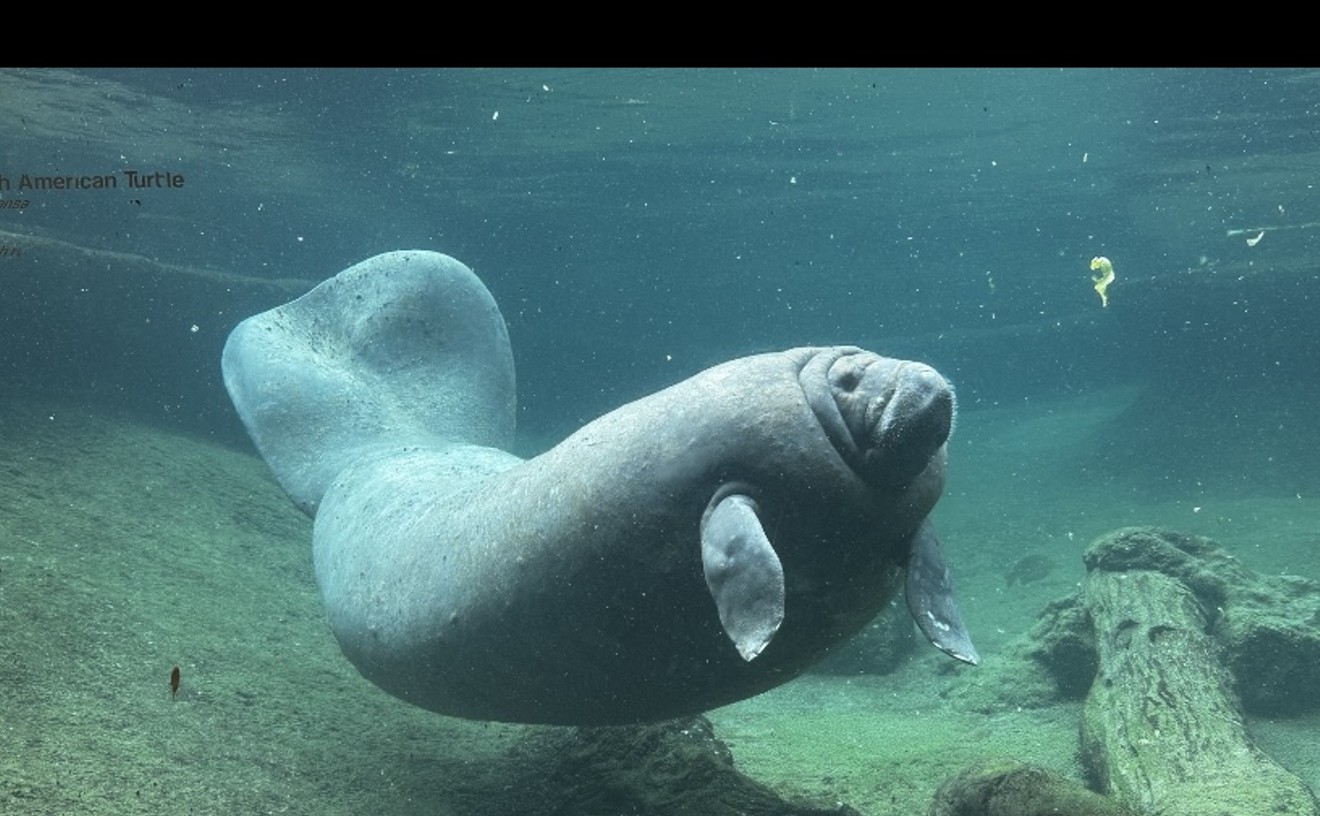On a damp September morning in 2006 at the edge of a sleepy Japanese fishing town, an orchestra of screaming voices echoed off the glistening rock walls of a hidden sea cove. Men in navy blue raincoats bobbed on 40-foot boats, hoisting spears nearly twice their height.
One by one, they brought the weapons down on the slick, rubbery backs of a cornered pod of dolphins — leaving the choppy, once-midnight-blue water an ominous syrupy crimson. When the work began, there were hundreds. When it finished, there were only 12 dolphins left alive. Afterward, hunters calmly tossed the lifeless mammals into piles on boats bound for a nearby meat-packing plant.
Ric O'Barry was there. Dressed in black, he clung to the side of a 100-foot rock wall with one hand and held a video camera in the other. The quietly handsome 69-year-old dolphin-trainer-turned-activist snatched the footage at Yoshino Kumano Kokuritsu Koen National Park in Taiji, Japan, to try to stop the slaughter.
The Coconut Grove native ended up both a hero and a target. A Dominican theme park recently sued him in South Florida for messing with its business. And he's the star of a soon-to-be nationally released heist documentary called The Cove — which in January took the Audience Award at the Sundance Film Festival. This all comes after a stint in jail and a handful of high-profile anti-captivity stunts that have made him one of the world's most publicly loathed — and loved — animal rights activists.
"What goes on there [in Japan] is so graphic. You smell the death; you hear the shrieks," he says. "I wanted to embarrass the government to the point they shut this thing down."
O'Barry, whose tired hazel eyes are framed by deep age lines, now lives in South Miami with his Danish wife and four-year-old adopted Chinese daughter. Though he loses sleep over dolphin mistreatment, in the mid-1960s he coached a dolphin named Kathy to play the title role for the TV series Flipper, which was set at a fictional South Florida marine park.
Everything changed one afternoon in March 1970. The then-30 year-old rode his bike from the Grove to Miami Seaquarium, where he learned Kathy was acting troubled. When he approached her cramped tank, she looked him in the eye, clenched her blowhole, and sunk to the bottom. She stayed under long enough to drown. "She literally died in my arms," he remembers. "I was sobbing." (That's possible, says Humane Society senior marine mammal scientist Naomi Rose: "Dolphins can decide not to live... out of stress, fear, and confusion.")
The next day, he impulsively flew to Bimini to free Charlie Brown, a caged dolphin he had once captured in Biscayne Bay. He rented a boat on a moonless night and piloted it into the dolphin's pen at Lerner Marine Lab. While trying to coax out the dolphin, the tide rose and trapped the vessel in the cage. Police arrested him for trespassing. (He served a week in jail.)
His stunts have since drawn attention from around the world, including the New York Times. He once strapped on a TV set with dead dolphin images and strolled into an International Whaling Commission meeting. Another time, he sat atop a submarine bomb he believed would harm sea life. He has also been a leader of the Free Lolita movement to release Miami Seaquarium's trained killer whale.
"He's a liar and a malcontent," says Robert Lingenfelser, president of the Marine Mammal Conservancy in Key Largo. "He's done nothing for marine mammals; he only shows up when the cameras are on."
Counters friend Glenn Terry: "Everybody in the industry hates him... But he's a hero."
Six years ago, O'Barry first voyaged to Taiji after he heard 2,300 dolphins annually were slaughtered there for meat. Soon he began making videos like the one he later shot from the edge of the cove wall. He sent them to places such as the Washington Post and the Japan Times. Nobody paid much attention. (Marion Renk-Richardson, producer for the German-based Spiegel TV, told New Times that O'Barry "fashioned himself a rock-star dolphin activist" but that she ultimately found him flaky.)
Then, in winter 2005, O'Barry met Louie Psihoyos, a veteran National Geographic photographer. O'Barry had been banned from speaking at a marine life conference at SeaWorld in San Diego after organizers realized he planned to show a video of dolphins being massacred. The tall, square-jawed photographer was curious about the censored speech, so he called the activist, who described "the killing cove."
"[O'Barry] is the most committed, tenacious, and passionate human I've ever met," Psihoyos says. "He routinely risks his life to save dolphins."
A week later, Psihoyos flew to Taiji and began to follow the activist around the cove with a video camera. "It's a formidable place," Psihoyos says. "It's basically a bunch of local thugs."
Though they set out to make an environmental exposé, the filming soon became more like Ocean's Eleven than An Inconvenient Truth. The cove, they found, was strictly patrolled by police, fenced-off with razor wire, and guarded by snarling dogs.
So they devised a plan to sneak in and set up hidden cameras. Using military-grade equipment fitted with night vision and heat sensors, they were able to detect and avoid night guards. They persuaded billionaire Netscape Communications founder Jim Clark to bankroll the film's $2.5 million budget.
On the damp morning of September 6, 2006, after recording the dolphin slaughter and capture of 12 dolphins, as shown in The Cove, O'Barry climbed down the rock wall and was greeted by waiting cops. Furious fishermen demanded he hand over the tape, but the police permitted him to leave with the footage.
O'Barry soon learned the 12 dolphins that were spared had been sent to the Taiji Whale Museum. The Japanese planned to transfer them to Ocean World Adventure Park, a resort three miles outside Puerto Plata in the Dominican Republic. The 35-acre complex, which offers a swim-with-the-dolphins program, agreed to pay the museum $154,000 per dolphin. Both organizations maintained the trade was "to promote research, conservation, and education" of the species.
But O'Barry insists the video proves the opposite: Taiji Whale Museum staffers were there the day of the hunt, and neither they nor the Dominican adventure park employees have any regard for the emotional, intelligent creatures.
Taiji Whale Museum manager Hiromitsu Nambu is adamant the claim is untrue. "The whale museum does not receive funds, encourage, or participate in any killing of dolphins for meat... Taiji is historically a whaling town, and the sale of live dolphins provides much-needed finance for education and research."
O'Barry says the notion they help dolphins is absurd. "It was all PR crap... So I exposed it." And that's where the legal trouble began.
In January 2007, O'Barry crafted a letter to Dominican Minister for Environment Max Puig, demanding he deny the dolphins' importation permits. "A violent and deadly capture took place," he wrote. "We have irrefutable evidence." (The minister denied permits.)
About three weeks later, with the help of a San Francisco-based nonprofit, O'Barry bought a full-page ad in Dominican Today and printed an open letter to President Leonel Fernández lambasting Ocean World. He also published an article on the website savejapandolphins.org that stated the resort was to blame for "the cruel, bloody capture of 12 dolphins."
Then he took it one step too far. On March 8, 2007, he appeared on Medio a Medio, a Santa Domingo political news program, and told a young female interviewer that Ocean World's general manager, Stefan Meister, was "blackmailing the president."(O'Barry says he was referring to a threat Meister made to pull the multimillion-dollar business out of the country.)
Ocean World wasn't happy and its lawyers got busy. The first lawsuit, filed in Miami-Dade in May 2007, claims O'Barry lied to media in order to depict Meister as "corrupt, a blackmailer, and a bad businessman." As a result, it asserts, Meister "has been brought into public scandal and disgrace." (Meister did not return phone calls requesting comment from New Times. Says Ocean World attorney Alexander Penalta: "It is our law firm's policy not to comment on this case.")
The second suit — filed in Broward at the same time — claims O'Barry intentionally sabotaged Ocean World's dolphin delivery contract. It asserts O'Barry "traveled to Japan and the Dominican Republic in order to unjustifiably interfere, harass, and stop the transfer." It also makes reference to "a distorted article" he ran online. They demanded $300 million in compensation.
Attorney Deanna K. Shullman is now taking O'Barry's cases pro bono. She believes the lawsuits are an attempt to silence the activist. "The only way he interfered was through pure political speech," she says. "That's what makes this case so offensive from a First Amendment perspective."
Of course, those lawsuits didn't boost O'Barry's fame like The Cove did. The 90-minute film received eight standing ovations at Sundance from January 15 through 25. The movie, completed just in time for the festival, will be released nationally in August. It makes no note of the legal claims against its main character.
On a recent Tuesday, in O'Barry's at-home office — ornamented with wooden dolphin statues and a worn acoustic guitar — he holds up a copy of the Japan Times like a trophy. A front-page headline reads, "Dolphin Slaughter Film a Hit at Sundance."
"At least it's finally getting out there," he says. "I'm not backing off."











